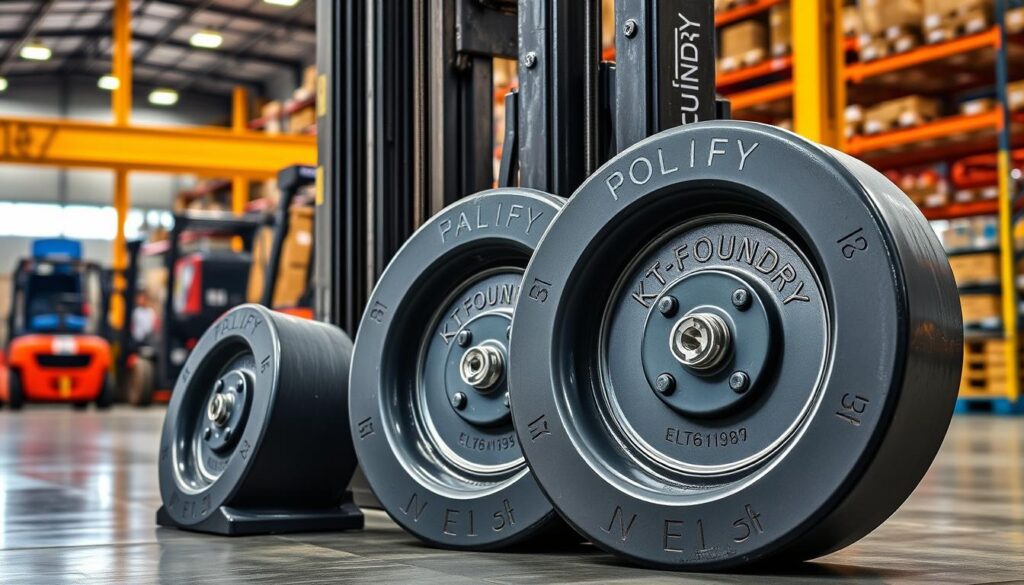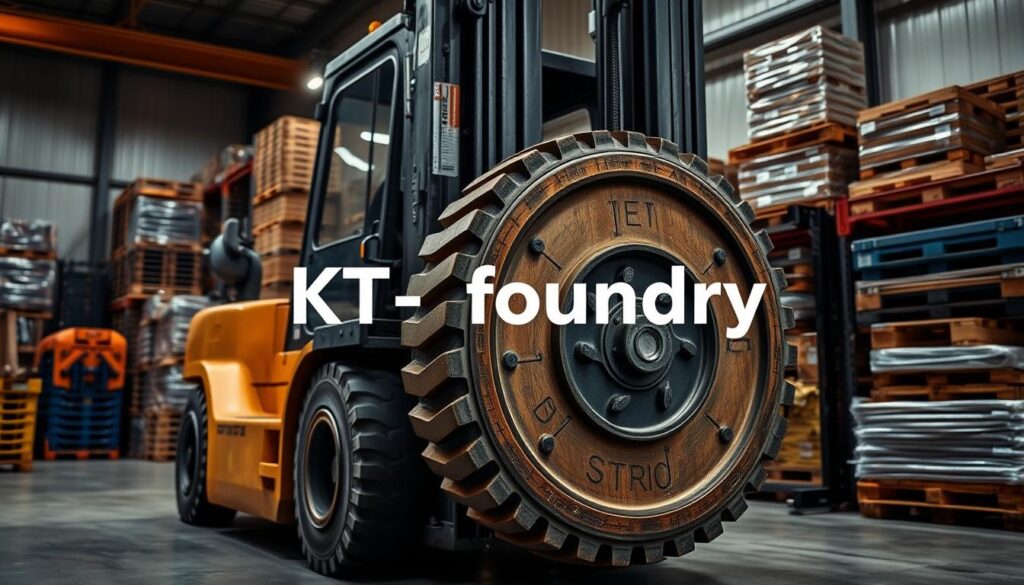Forklifts are key in industries like manufacturing, construction, and warehousing. They help lift, move, and transport heavy items. The counterweight is a big part of a forklift, making sure it doesn’t tip over. It’s usually made of steel, iron, or concrete and can be very heavy, up to 10,000 pounds.
Without a counterweight, forklifts would be unstable and unsafe. That’s why managing forklift counterweights is so important. It keeps forklifts stable, safe, and efficient. This helps keep workers safe and makes work easier.
Key Takeaways
- Forklift counterweights are key for keeping forklifts stable and safe.
- They balance the load, stopping the forklift from tipping over.
- Counterweights can be as light as 1,000 pounds or as heavy as 10,000 pounds, based on the forklift’s size and capacity.
- Good management of counterweights is key for the best forklift performance and efficiency.
- Choosing top-quality counterweights from trusted makers is vital for safe and reliable use.
Understanding the Role of Forklift Counterweights
Forklift counterweights are key to keeping these machines stable and safe. They help distribute the weight of the forklift, making sure it doesn’t tip over when carrying heavy loads.
What are Forklift Counterweights?
Counterweights are heavy parts, often made of steel, iron, or concrete, added to the back of forklifts. They can range from 1,000 to 10,000 pounds, based on the forklift’s size and capacity. Their main job is to balance the weight of the load on the forklift’s front, preventing it from tipping.
The Function of Forklift Counterweights
Counterweights do several important things. They keep the forklift’s center of gravity in check, making sure it stays stable with heavy loads. This boosts the forklift’s stability and safety, lowering the chance of accidents. Plus, adjusting the counterweights lets the forklift work with different loads and in various settings.
“Proper use and maintenance of forklift counterweights is essential for ensuring the safe and efficient operation of these essential material handling machines.”
Knowing how forklift counterweights work helps operators and managers keep their forklifts running well. It also keeps workers safe and operations stable.

forklift counterweights: Ensuring Safety and Stability
Forklift counterweights are key to keeping forklifts safe and stable. They balance out the weight of the load, preventing the forklift from tipping or losing control. Let’s look at the different types of counterweights and which forklifts use them.
Types of Forklift Counterweights
There are many types of forklift counterweights, each designed for specific forklift models and tasks. Cast iron counterweights are popular for their durability and easy upkeep. Steel counterweights are stronger and better suited for heavy-duty forklifts. Concrete counterweights are the heaviest and used in the biggest forklifts, offering top stability.
Forklifts that Use Counterweights
Almost all forklifts, big or small, need counterweights to stay stable when lifting heavy loads. This includes electric counterbalance forklifts, internal combustion forklifts, rough terrain forklifts, side loader forklifts, and telescopic handler forklifts. The right size and type of counterweight depend on the forklift and its job, ensuring it works well and safely.
“Proper forklift counterweights are essential for maintaining stability and preventing tipping, ultimately ensuring the safe and efficient operation of these vital material handling machines.”
Conclusion
The forklift counterweight is key to keeping the forklift stable and balanced when lifting heavy loads. Different types of counterweights exist, based on the forklift’s size and capacity. Keeping the counterweight in good shape is vital for the forklift’s safety and stability.
Following these guidelines helps operators use forklifts safely and efficiently. This increases productivity and cuts down on accidents. The forklift counterweight is crucial for safe and efficient use of these machines. It’s a must-have for any industrial operation that involves heavy lifting.
At KT Foundry, we focus on making high-quality counterweights for our clients’ machinery needs. Our expertise and dedication to excellence mean our customers can count on their forklifts for stability and safety. This boosts their productivity and profits.
FAQ
What are forklift counterweights?
Forklift counterweights are heavy parts added to the back of a forklift. They help balance the weight of the load and prevent the forklift from tipping. They can be made of steel, iron, or concrete and weigh from 1,000 to 10,000 pounds.
What is the primary function of a forklift counterweight?
The main job of a forklift counterweight is to balance the load’s weight. It makes sure the forklift stays stable and doesn’t tip. It also keeps the forklift stable by lowering its center of gravity.
What are the different types of forklift counterweights?
There are many kinds of forklift counterweights, each for different forklifts and jobs. Cast iron, steel, and concrete are common types. Cast iron is often used in smaller forklifts. Steel is better for heavy-duty tasks because it’s strong and durable. Concrete is the heaviest and used in the biggest forklifts, offering great stability but costing more.
What types of forklifts commonly use counterweights?
Many forklifts need a counterweight to stay stable when lifting heavy loads. The size and type of counterweight depend on the forklift’s size and capacity. Electric, internal combustion, rough terrain, side loader, and telescopic handler forklifts often use them.


